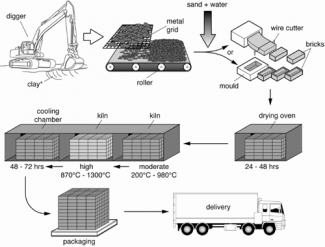The diagram below shows the process by which bricks are manufactured for the building industry.
Summarise the information by selecting and reporting the main features, and make comparisons where relevant.

The diagram illustrates how bricks are made for and delivered to the building industry.
Overall, there are seven stages in the process, beginning with clay excavation and ending with the delivering of bricks to customers.
To begin, the clay used to make bricks are dug up from the ground by the large digger. Next, this clay is placed into a metal grid which is removed oversize of pieces and dropped into the large roller.
Following this, sand and water are added to the small clay and mixture is turned into bricks by placing it into a mould or using a wire cutter. The process continues with these bricks are put in an oven dry to evaporate for 24 to 48 hours. Subsequently, the bricks fried in a kiln at moderate and then a high temperature from 870oC to 1300oC before going through a cooling chamber for 2 to 3 days. Finally, the bricks are packed and delivered to their destinations.
Comments
The given diagram illustrates
The given diagram illustrates different stages of manufacturing of bricks for building industries.
Overall, brick production involves seven stages, starting with digging clay and ending with delivery.
First of all, the clay which is used for brick manufacturing are dug from ground by digger.Then, the clay is placed on metal grid for filtering unwanted substances and dropped into the roller and then mixed with sand and water. In third stage, the mixture is kept either in mold or wire cutter to shape the raw bricks. In the next stage, the raw bricks are dried in oven for 24 to 48 hours. After that, the dried raw bricks are kept in kiln in both moderate and high temperature starting from 200 degree Celsius up to 1300 degree Celsius and then placed in cooling chamber for 48 to 72 hours.Finally the bricks are packed and delivered to their destination by trucks.


Transition Words or Phrases used:
finally, then
Attributes: Values AverageValues Percentages(Values/AverageValues)% => Comments
Performance on Part of Speech:
To be verbs : 9.0 7.0 129% => OK
Auxiliary verbs: 0.0 1.00243902439 0% => OK
Conjunction : 8.0 6.8 118% => OK
Relative clauses : 1.0 3.15609756098 32% => OK
Pronoun: 5.0 5.60731707317 89% => OK
Preposition: 30.0 33.7804878049 89% => OK
Nominalization: 1.0 3.97073170732 25% => More nominalizations (nouns with a suffix like: tion ment ence ance) wanted.
Performance on vocabulary words:
No of characters: 736.0 965.302439024 76% => OK
No of words: 160.0 196.424390244 81% => More content wanted.
Chars per words: 4.6 4.92477711251 93% => OK
Fourth root words length: 3.55655882008 3.73543355544 95% => OK
Word Length SD: 2.49921862789 2.65546596893 94% => OK
Unique words: 99.0 106.607317073 93% => More unique words wanted.
Unique words percentage: 0.61875 0.547539520022 113% => OK
syllable_count: 227.7 283.868780488 80% => OK
avg_syllables_per_word: 1.4 1.45097560976 96% => OK
A sentence (or a clause, phrase) starts by:
Pronoun: 1.0 1.53170731707 65% => OK
Article: 5.0 4.33902439024 115% => OK
Subordination: 0.0 1.07073170732 0% => More adverbial clause wanted.
Conjunction: 0.0 0.482926829268 0% => OK
Preposition: 1.0 3.36585365854 30% => More preposition wanted as sentence beginning.
Performance on sentences:
How many sentences: 8.0 8.94146341463 89% => OK
Sentence length: 20.0 22.4926829268 89% => OK
Sentence length SD: 29.6257911287 43.030603864 69% => OK
Chars per sentence: 92.0 112.824112599 82% => OK
Words per sentence: 20.0 22.9334400587 87% => OK
Discourse Markers: 1.625 5.23603664747 31% => More transition words/phrases wanted.
Paragraphs: 4.0 3.83414634146 104% => OK
Language errors: 0.0 1.69756097561 0% => OK
Sentences with positive sentiment : 0.0 3.70975609756 0% => More positive sentences wanted.
Sentences with negative sentiment : 0.0 1.13902439024 0% => More negative sentences wanted.
Sentences with neutral sentiment: 8.0 4.09268292683 195% => OK
What are sentences with positive/Negative/neutral sentiment?
Coherence and Cohesion:
Essay topic to essay body coherence: 0.165285025394 0.215688989381 77% => OK
Sentence topic coherence: 0.078766377803 0.103423049105 76% => OK
Sentence topic coherence SD: 0.0636312618699 0.0843802449381 75% => OK
Paragraph topic coherence: 0.116840496931 0.15604864568 75% => OK
Paragraph topic coherence SD: 0.0712073795148 0.0819641961636 87% => OK
Essay readability:
automated_readability_index: 10.2 13.2329268293 77% => Automated_readability_index is low.
flesch_reading_ease: 68.1 61.2550243902 111% => OK
smog_index: 8.8 6.51609756098 135% => OK
flesch_kincaid_grade: 8.7 10.3012195122 84% => OK
coleman_liau_index: 9.4 11.4140731707 82% => OK
dale_chall_readability_score: 8.18 8.06136585366 101% => OK
difficult_words: 36.0 40.7170731707 88% => OK
linsear_write_formula: 11.0 11.4329268293 96% => OK
gunning_fog: 10.0 10.9970731707 91% => OK
text_standard: 9.0 11.0658536585 81% => OK
What are above readability scores?
---------------------
Rates: 84.2696629213 out of 100
Scores by essay e-grader: 7.5 Out of 9
---------------------
Note: the e-grader does NOT examine the meaning of words and ideas. VIP users will receive further evaluations by advanced module of e-grader and human graders.